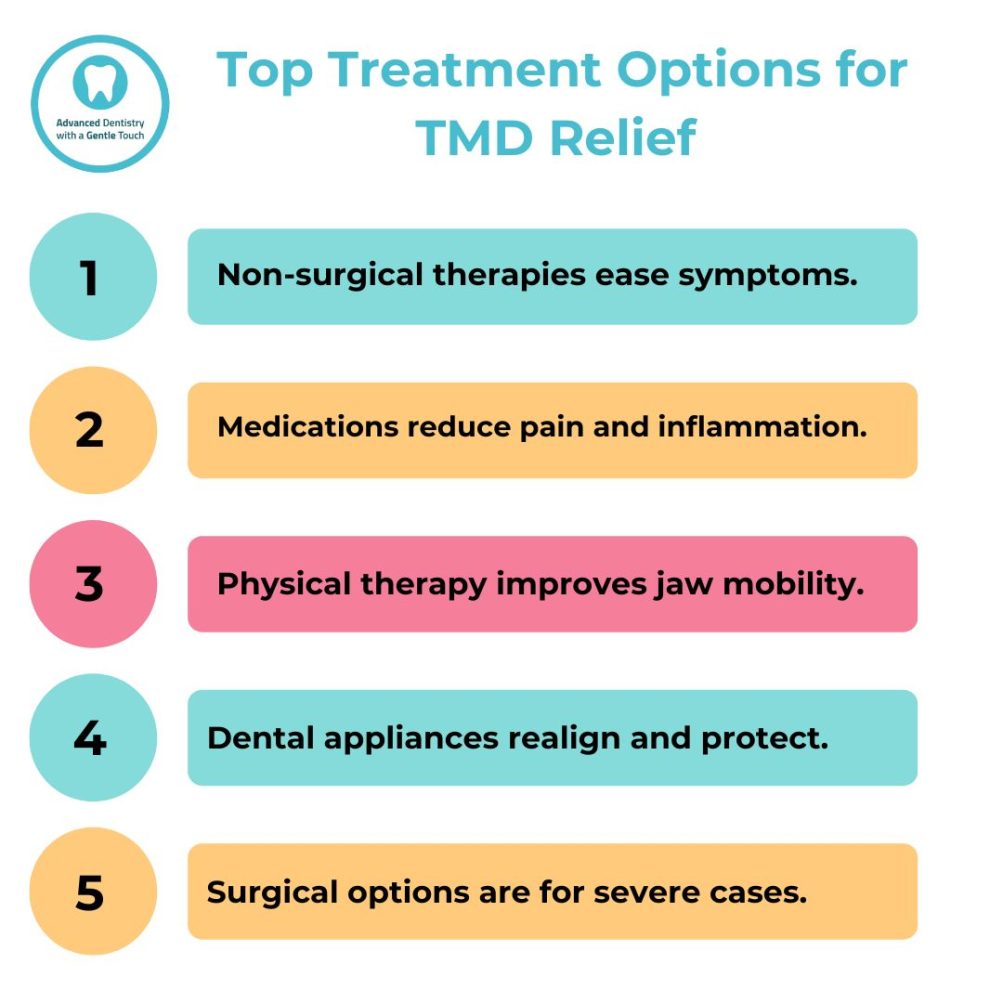Top Treatment Options for TMD Relief

Temporomandibular Disorders (TMD) refer to a group of conditions that affect the temporomandibular joint (TMJ), which connects the jaw to the skull. TMD can significantly impact daily life, causing symptoms like jaw pain, frequent headaches, and difficulty with basic activities such as chewing and speaking. The discomfort from TMD often goes beyond the jaw. It affects the neck and shoulders and even leads to tension headaches, which can hinder day-to-day activities.
Managing these symptoms is essential for anyone dealing with TMD. Left untreated, TMD can worsen, intensifying pain and restricting jaw movement. Effective treatment can provide relief, enhance quality of life, and prevent further complications. From non-invasive lifestyle changes to targeted therapies and advanced surgical options, a wide range of treatment approaches is available to help patients find lasting relief.
Understanding these treatment options is crucial. With advancements in dentistry, patients now have access to various methods that address different severity levels of TMD. This allows for a personalized approach to managing symptoms and restoring comfort.
Understanding TMD and Its Causes
What is TMD?
Temporomandibular Disorder (TMD) is a condition affecting the temporomandibular joint (TMJ), which connects the jaw to the skull. While TMJ refers to the joint itself, TMD encompasses the range of issues impacting this joint, often leading to jaw pain and restricted movement.
Common symptoms of TMD include jaw discomfort, limited mobility, and pain around the jaw and ear, which can make daily activities like eating and speaking difficult. In some cases, TMD symptoms can also lead to tension headaches or neck pain, affecting overall well-being.
Common Causes and Risk Factors
TMD can develop from various causes, with physical trauma to the jaw or head being one of the primary factors. Additionally, conditions like arthritis can contribute to TMD, especially when they cause inflammation in the joint. Stress is another significant contributor, often leading people to clench their jaw or grind their teeth, which strains the TMJ and aggravates symptoms.
Lifestyle factors, like poor posture or a diet high in hard-to-chew foods, can also increase the risk of TMD. Some people may have a genetic predisposition to TMD, making them more susceptible to this condition. By understanding these risk factors, individuals can take proactive steps toward TMD prevention and management, reducing the risk of pain and jaw dysfunction.

Non-Surgical Treatment Options for TMD
Comprehensive Bite Analysis and Correction for TMD
Addressing Temporomandibular Disorders (TMD) begins with a thorough analysis of bite alignment. Bite misalignments, or malocclusions, are significant contributors to strain on the temporomandibular joint (TMJ). These often worsen symptoms like jaw pain, limited mobility, and muscle tension. Correcting these misalignments can bring substantial relief and improve overall jaw function.
Methods of Bite Correction
When bite misalignment is confirmed as a factor in TMD, personalized treatment options are designed to address the issue. These interventions include:
Orthodontic Treatment
Orthodontic solutions, such as Invisalign aligners or traditional braces, are effective tools for correcting misaligned teeth. By realigning the bite, these treatments help distribute pressure evenly across the TMJ, reducing symptoms.
Occlusal Equilibration
This technique involves reshaping the biting surfaces of the teeth to achieve a balanced bite. Small adjustments prevent excess stress on specific areas of the jaw, reducing the risk of eccentric jaw movement that strains the TMJ. Research indicates that occlusal equilibration alleviates muscle tension and enhances jaw alignment in many TMD cases.
See also Master of the Academy of General Dentistry
Restorative Dentistry
For patients with damaged, worn, or missing teeth, restorative options like crowns, bridges, or veneers can realign the bite. Properly restored teeth ensure even contact, minimizing uneven pressure and reducing the risk of grinding, which can trigger TMD flare-ups.
Orthognathic Surgery (For Severe Misalignments)
For complex jaw discrepancies where non-invasive treatments fall short, orthognathic surgery may be necessary. This procedure corrects structural jaw misalignments, realigning the upper and lower jaws for optimal function. Though considered a last resort, evidence shows that orthognathic surgery can provide long-term relief for severe TMJ dysfunction caused by skeletal irregularities.
Tailoring Treatment to TMD Causes
Bite correction is only appropriate when misalignment is a confirmed contributor to TMD. Not all TMD cases stem from malocclusions, and unnecessary adjustments could worsen symptoms. A comprehensive diagnostic evaluation, including imaging studies, bite analysis, and a detailed review of symptoms and history, is essential to determine the best course of action.
Supporting Evidence
Research consistently supports the connection between bite correction and TMD symptom relief. Studies published in The American Journal of Orthodontics and Dentofacial Orthopedics highlight the efficacy of treatments targeting malocclusions. When combined with interventions like physical therapy or stress management, these approaches significantly alleviate TMJ strain and improve outcomes for TMD patients.

Medication for Pain and Inflammation
Managing TMD often begins with medications aimed at reducing pain and inflammation. Nonsteroidal anti-inflammatory drugs (NSAIDs), like ibuprofen, are commonly used to relieve jaw pain and reduce swelling in the temporomandibular joint.
For more severe discomfort, muscle relaxants may be prescribed to ease muscle tension around the jaw, helping to prevent involuntary clenching. In some cases, corticosteroids may be used to manage acute inflammation, offering relief for TMD flare-ups and helping restore comfort during daily activities.
Physical Therapy and Jaw Exercises
Physical therapy is an effective approach for enhancing jaw mobility and alleviating TMD symptoms. Through targeted exercises, physical therapy strengthens the jaw muscles, improves flexibility, and can significantly reduce jaw discomfort and pain.
Simple exercises, such as gentle jaw stretches or holding the mouth open in a relaxed position, can help relieve tension and improve range of motion. Specific TMD exercises, such as resisting opening and closing motions with light pressure, may also help strengthen jaw muscles and promote better function of the TMJ. These exercises, combined with physical therapy, can be beneficial in managing TMD long-term.
Dental Appliances and Orthodontic Adjustments
Dental appliances like mouthguards or splints can offer relief by minimizing teeth grinding and reducing the pressure on the TMJ. These devices are typically worn at night to prevent clenching and grinding, behaviors that can worsen TMD symptoms. Splints and guards help keep the jaw in a neutral position, reducing strain on the temporomandibular joint.
In cases where misalignment is contributing to TMD, orthodontic adjustments, such as braces, may be recommended. Correcting teeth alignment can relieve pressure on the TMJ and improve jaw function over time. Orthodontic solutions address the root cause of alignment-related TMD, offering a path to lasting relief for many patients.

Surgical Treatment Options for TMD
Minimally Invasive Procedures
When non-surgical treatments for TMD are not sufficient, minimally invasive options like arthrocentesis and arthroscopy may be recommended. Arthrocentesis, also known as joint lavage, involves flushing the joint with a sterile solution to remove any debris and reduce inflammation. This procedure can help relieve pain and improve joint mobility, especially in cases where the jaw is locked or movement is restricted.
See also Caring for Your Single Dental Implant: Tips and Best Practices
Arthroscopy, another minimally invasive approach, involves inserting a small camera into the joint. This approach allows the surgeon to view and treat issues directly, such as removing scar tissue or repositioning the disc.
Both procedures are typically outpatient treatments with shorter recovery times and fewer risks compared to open-joint surgery. Patients often experience immediate relief from TMD symptoms and can return to their normal activities sooner. Minimally invasive methods are ideal for those seeking effective TMD treatment with minimal disruption to their daily lives.
Open-Joint Surgery
In severe or chronic TMD cases, where conservative treatments and minimally invasive options have proven ineffective, open-joint surgery may be necessary. This more extensive surgical procedure allows the surgeon to directly access the temporomandibular joint to repair or replace damaged components. Open-joint surgery is usually considered a last resort. It is reserved for patients experiencing significant pain or functional impairment that hinders daily activities.
While open-joint surgery can be highly effective for severe TMD, it comes with potential risks. These include infection, nerve damage, or a longer recovery period. However, for patients who have exhausted other options, this procedure may provide substantial, lasting relief and restore the jaw’s full function. This makes it a viable solution for complex TMD cases.
Alternative and Complementary Therapies
Acupuncture and Acupressure
Acupuncture is a well-regarded alternative therapy for managing TMD pain and alleviating stress that can exacerbate symptoms. This technique involves inserting fine needles into specific points on the body to balance energy flow and relieve pain.
For TMD, acupuncture targets areas around the jaw, neck, and shoulders to reduce muscle tension and enhance joint mobility. Many patients report noticeable relief from jaw discomfort and reduced frequency of TMD flare-ups after acupuncture sessions. This is what makes it a popular choice for natural pain management.
Acupressure provides similar benefits without the use of needles. This method involves applying gentle pressure to specific points associated with jaw tension, helping to relieve stress in the muscles surrounding the TMJ. Regular acupressure can help manage TMD symptoms effectively, especially for those who prefer non-invasive techniques to ease jaw pain.
Chiropractic Care and Osteopathy
Chiropractic care and osteopathy are hands-on therapies that can play a role in managing TMD by addressing alignment issues. Chiropractors and osteopaths focus on improving the alignment of the jaw and neck to reduce strain on the TMJ.
Adjustments and manipulations target the muscles and joints surrounding the TMJ, helping to relieve pressure and improve movement. Specific techniques, such as gentle adjustments to the upper spine or realignment of the jaw, can offer significant relief for TMD sufferers by reducing tension in the temporomandibular joint.
Both chiropractic care and osteopathy aim to restore balance in the body, which can help alleviate TMD symptoms and reduce the likelihood of recurring pain or discomfort.

Massage Therapy and Myofascial Release
Massage therapy is another effective approach for easing tension in the jaw muscles and reducing stress around the TMJ. Techniques like deep tissue massage focus on relaxing the muscles that control jaw movement, which can relieve pain and improve mobility. Massage also promotes blood flow to the affected area, aiding in the healing process for strained muscles and ligaments.
Myofascial release is a specialized massage technique that targets the fascia, or connective tissue, surrounding the jaw muscles. This method focuses on releasing deeper muscle tension, which can help relieve persistent TMD symptoms. By loosening the fascia, myofascial release can improve jaw function and reduce discomfort, offering an alternative solution for those seeking natural TMD relief.
See also Dental Health Tips: "Sip All Day, Get Decay"
Lifestyle Changes and Home Remedies for TMD Relief
Stress Management and Relaxation Techniques
Managing stress is crucial for TMD relief, as stress often contributes to jaw clenching and teeth grinding, which can worsen TMD symptoms. Incorporating relaxation techniques into daily routines can help reduce jaw tension and prevent flare-ups.
Deep breathing exercises can calm the mind and relax the muscles around the jaw. Meditation, focusing on mindfulness, can help patients become more aware of and control jaw-clenching or teeth-grinding habits. Additionally, yoga, with its focus on controlled breathing and muscle relaxation, can ease both physical and mental tension, offering lasting relief for TMD-related stress.
Dietary Modifications and Jaw-Friendly Habits
Dietary adjustments can also significantly reduce strain on the TMJ. Avoiding hard or chewy foods, like nuts or tough meats, helps prevent overexertion of the jaw muscles. Opting for softer foods or cutting food into smaller, manageable bites can further reduce pressure on the joint. Alongside dietary changes, adopting jaw-friendly habits is essential for managing TMD symptoms.
Practicing good posture, especially for those who work at a desk, can reduce strain on the jaw and neck. Avoiding habits that place unnecessary pressure on the jaw, such as excessive gum chewing or nail-biting, can also prevent TMD flare-ups. By making small lifestyle adjustments, individuals can support their TMJ health and reduce the frequency and intensity of TMD symptoms.
Preventing TMD Symptoms from Worsening
Recognizing Early Warning Signs
Early recognition of TMD symptoms can significantly improve the management of the condition. Paying attention to signs like jaw pain, clicking sounds, or limited movement can help individuals take proactive steps to prevent TMD from worsening. Simple discomfort, if ignored, can progress into chronic pain, so it’s essential to address symptoms as soon as they appear. Regular dental check-ups are valuable in this regard, as they allow a dentist to monitor TMJ health, catch any potential issues early, and recommend preventive care.
Importance of Consistent Care and Follow-Up
For those diagnosed with TMD, consistent care and follow-up are crucial for long-term relief. Following a treatment plan, whether it involves medications, exercises, or lifestyle changes, helps prevent symptoms from escalating.
Attending follow-up appointments allows for ongoing assessment of the treatment's effectiveness and provides opportunities for adjustments if necessary. Maintaining a routine of consistent care is essential for managing chronic cases. Doing so ensures lasting relief and promotes overall TMJ health.
Conclusion
TMD treatment options range from non-surgical approaches, like medications, physical therapy, and dental appliances, to surgical solutions for severe cases. Minimally invasive procedures, such as arthrocentesis and arthroscopy, offer relief with shorter recovery times, while open-joint surgery is reserved for chronic, unmanageable symptoms.
Alternative therapies, including acupuncture and chiropractic care, and lifestyle changes, like stress management and dietary adjustments, can also help control TMD symptoms. By combining these approaches, individuals can manage TMD effectively and achieve lasting relief.
Dr. Korwin, a dentist in Middletown, NJ, with years of experience in the field, offers a range of treatment options for TMD relief that are tailored to each patient’s needs. If you’re ready to take the first step toward managing your temporomandibular joint disorder, visit korwin.com to explore more about available treatments and to start your journey to a more comfortable, pain-free life.
